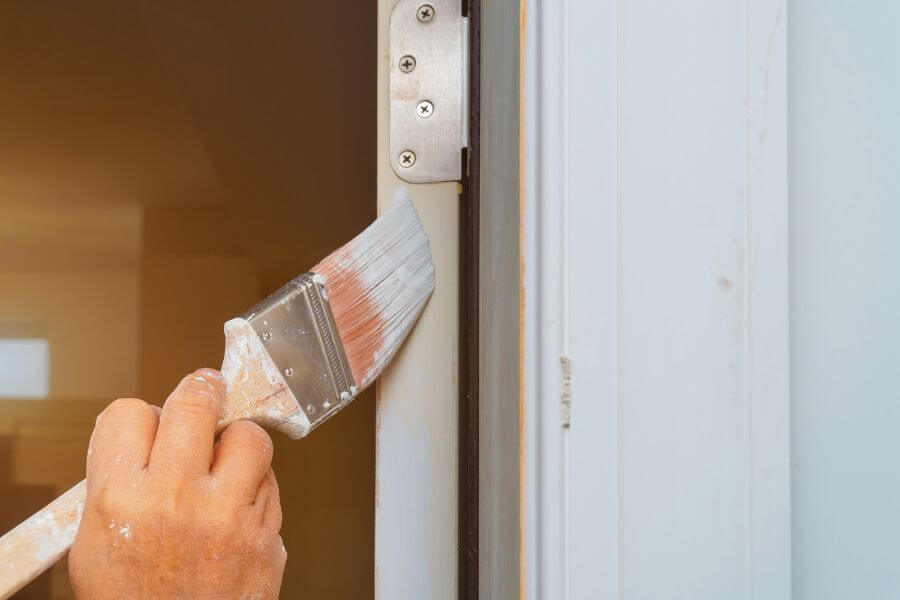Painting the doors on your own instead of hiring professionals is a great idea if you want to save money from labor. Besides, it doesn’t look as hard as it appears to be.
However, this isn’t the case because it could lead to mishaps, such as the paint sticking to the door if done incorrectly.
How will you unstick a painted color if the damage has already been done?
The basic procedure to unstick a painted door is that you have to readjust and re-hung the door if it’s necessary. If it’s unsuccessful, you can use other devices such as lubricants, sand, or planing.
In this article, I will show you how you can fix the thick and sticky consistency of the paint on your door. In addition, you’ll learn why a newly painted door is sticking so you can avoid them the next time.
Why Is My Newly Painted Door Sticking?

The following are some of the common reasons why a newly painted door is sticking:
Improper Hinge Installation
One of the possible reasons why the newly painted doors are sticky may be due to the improper installation of the door hinges. Such an instance could happen, especially if there’s a thick layer of paint on where the hinges will be placed.
High Paint Saturation
Sometimes you may feel that you are not applying enough paint on a specific surface. As a result, you tend to apply too much paint more than what is necessary. The high saturation of paint hinders it from completely drying, leading to a gluey texture.
Oil-Based Paint
It is important to check the content of the paint you are buying. For one thing, oil-based paint is much thicker compared to water-based paint. Oil-based paint will take about 24 hours to dry completely, so you’ll have to wait a day before applying a second coat of paint.
Exposure to the Elements
The paint being exposed to the elements and weathering could ruin the integrity of the application, leading to the door’s stickiness.
This is especially true during the hot weather that could melt the paint if they are not properly sealed—the paint absorbs moisture that softens the composition of the paint.
How Do I Fix My Painted Door From Sticking?
Having mishaps in painting your door is almost inevitable, especially if it’s your first time doing it. However, it is not a hopeless case.
You can successfully paint your doors like a pro by following the tips below.
Prepare the Painted Door
First and foremost, you need to prepare the door with sticky paint. And you prepare them by removing the hinges and positioning them where you can sand them properly to apply the fresh new paint.
You can use regular sandpaper or an electric sander to speed up the process. But no matter what it may be, sanding them outside the house or in your garage is important.
Example of a regular sandpaper
Use a damp cloth to smooth the surface and remove the excess paint and debris from the sanding process. In addition, you may have to apply fillers if you observe any cracks in the wood.
Lastly, use a primer solution and apply them evenly. A primer is a type of wood treatment that is applied to make the paint last longer.
Re-Paint the Wood
Now that we already know the mistake we made the last time, you can re-paint the door and make it as perfect as possible. And one of the most common mistakes many people make is applying thick paint on the doors to get a deeper depth.
Many believe they are improving the color depth, but they’re making it worse because denser paint dries longer than those applied in ample amounts.
Be mindful and take time to paint all corners of the doors. And then, you have to wait for a couple of hours until it completely dries before you apply a second level of coating.
Apply Lubricants
Applying lubricants to the edges of the door helps prevent the paint’s gluey texture. Fortunately, you don’t have to use a lubricant solution spray that you can find in your local home depot.
Some household items such as paraffin wax, dry bar soap, or petroleum jelly can be purposed as a lubricant for this purpose.
Before using the lubricant, you must ensure that the second coat of paint has completely dried up. After applying the lubricants, rub them thoroughly until they are evenly distributed on the door’s edges.
Hinge Adjustments
Put the hinges back together and adjust them accordingly. Ensure the screws are tightly put into place to prevent the paint coat from damaging and becoming sticky.
You may also replace the screws and hinges altogether whenever you see fit.
Use Sandpaper to Remove Excess Paint
If the door’s edges are still sticky after following the tips discussed previously, it only means that the paint is still thick and did not dry properly.
Before you redo the entire process, there’s still one more solution that you can try. Use sandpaper again to remove the buildup of paint around the bottom edges of the door.
It allows the door’s latch to work properly without the paint intervening.
How Long Should I Leave a Door Open After Painting It?
You may have to leave the paint for about two hours at least to be sure that the paint has completely dried up and cured correctly. In addition, the recommended period of waiting works effectively in a humid environment.
Frequently Asked Question
Why Won’t My Doors Close After Painting?
One of the common reasons why a door isn’t closing correctly after the painting is that the coating is too thick and sticky, which interferes with the door’s latching mechanism.
The other thing is that the hinges were not correctly installed due to the excess paint inside them.
How Long Does It Take a Painted Door to Dry?
Regular water-based or acrylic latex paint would only take 24 hours to dry and cure after applying the final coating.
However, this isn’t exactly the case with oil-based paint applied densely on the doors. It may take them over 24 hours to dry completely.
Also, they are among the many reasons why the paint of the door is becoming stuck and making it hard for you to open and close them.
Will Vaseline Stop the Paint From Sticking?
Vaseline has a petroleum substance that can be used as a lubricant. If you have gluey paint on your door, apply it to the surface and rub it evenly.











